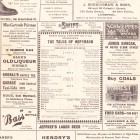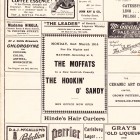Zauberflöte 1914Carl Rosa Opera Company
Read more about the opera Magic Flute
One highlight of this 1914 visit to Edinburgh by the Royal Carl Rosa was a further local airing of The Jewels of the Madonna by Ermanno Wolf-Ferrari, introduced last year, and now given at the Saturday matinee. Aïda had not featured for several seasons, and the Carl Rosa had not brought it north for over twenty years. The Magic Flute and Tales of Hoffmann were also, at long last, becoming popular favourites. Cast details for this Magic Flute on Thursday, and Tales of Hoffmann on the Friday, are taken from our copy of the programme - see images below.
Certain aspects of the translation by E J Dent are worth mentioning. The second Priest does not appear as a separate identifiable role - presumably the Speaker covered that part as well. The three guides usually described nowadays simply as 'Boys' are here 'Genii', with the top two voices apparently swapping roles since 1913. An interesting feature is the naming of the Three Ladies in attendance on the Queen of Night. They become Aretusa, Egle and Iperetusa, perhaps relics of the old Italian translation by Gamerra often used during the nineteenth century. (These can be seen in the copy illustrated below). However the Queen herself is no longer called Astrafiammante - the star-blazing queen, though she is described thus in the dialogue.
Two Edinburgh Critics
Edinburgh Evening News: Friday, 27 February 1914 (p4)
Carl Rosa Company in The Magic Flute
'The Magic Flute has never been one of Mozart's really popular works; the plot is so intricate that it is almost impossible to follow. But the beautiful music and the superb modern staging made possible by the Egyptian setting of the story, which takes place in the temples of the initiates, makes a strong appeal alike to eye and ear. And in last night's presentation of the work no pains had been spared on the side of costuming and stage setting, the processions of priests in their gorgeous robes through the halls of Sarastro's Palace being specially effective.
'Prodigal as Mozart always is in the matter of solo artistes required, the list of the dramatis personae of The Magic Flute is a hopelessly long one to catalogue. But mention must be made of the excellent singing of Edward Davies in the leading role of Tamino. So well placed is his voice that it sounds as fresh at the end of the evening's work as at the beginning. Dignified and impressive as the High Priest, Sarastro, Arthur Winckworth had a part more than ordinarily suited to the rich quality of his voice. Beatrice Miranda and Pauline Donnan as the Queen of the Night and her daughter bore the chief burden of the prime donne, Pauline Donnan as Pamina, the daughter, coming admirably through the ordeal of singing the very heavy music of the part. Beatrice Miranda gave a good account of the famous florid music of the Queen of the Night.
'The humorous element was provided by Frederick Clendon and Dorothy Lawson Taylor in the comic parts of Papageno and Papagena, the birdcatchers. The audience was enthusiastic and would have liked encores, but the great length of the opera made it impossible to concede them. Mr Walter Van Noorden conducted. The season closes this week with a repetition of The Tales of Hoffmann, Jewels of the Madonna, and Trovatore.
Scotsman: Saturday, 28 February 1914
'The irrelevancies of the plot (which was concocted by a stage manager for public consumption when Mozart was practically on his death-bed) are all overcome by virtue of good music. The broad lines of Shikanader's libretto and setting of spectcular scenes are so obviously artificial that they may be taken just for what they are worth. They have no literary value; they supply the material and scenario for music. In the dressing and staging the work was well presented and the Egyptian scenery was striking. In the vocal presentation first honours fell undoubtedly to the Papageno of Mr Frederick Clandon. He played up to the grotesque humour of the part; he sang with great effect, and whether he was singing or speaking he gave the audience all the words. It was, indeed, a finely studied buffo part, conceived in a style which is, unfortunately for operatic art, going out."
As Papagena, Miss Dorothy Lawson-Taylor may be associated with the success which the great duet in the final act obviously, by the test of the applause of all present in the theatre, achieved. The Tamino of Mr Edward Davies, if sometimes wanting in the dignity of stage presence, was equally fine, and he has merit of giving his audience all the words. Other notable parts in a long list were the Queen of the Night of Miss Beatrice Miranda, who one great applause in her prominent solos, both in the first and second acts; the Sarastro of Mr Arthur Winckworth, whose rendering of "Within the Hallowed Dwelling" brought so much applause that he had to return to the stage three times...Mr Van Noorden, who conducted, kept the orchestra well in hand, and although complaint may once again be entered against the unnecessarily long intervals, the audience was never permitted to become wearied while the work was in progress.'
Carl Rosa in Scotland - 1914
The 1914 season was unusual in that it was restricted to five weeks in total, and all those in the central belt. One week at Greenock (King's), and two in Edinburgh (Lyceum), were followed by two in Glasgow (Theatre Royal).
The somewhat reduced repertoire consited of twelve operas in all. These were by Mozart (Marriage of Figaro, Magic Flute); Wallace (Maritana); Wagner (Tannhäuser, Lohengrin); Verdi (Trovatore, Aïda); Thomas (Mignon); Gounod (Faust) Offenbach (Tales of Hoffmann); Bizet (Carmen); Wolf-Ferrari (Jewels of the Madonna).
The five-week tour schedule was as follows:
Greenock: w/c 9 February: Mon 9 Magic Flute; Tue 10 Carmen; Wed 11 Tales of Hoffmann; Thu 12 Trovatore; Fri 13 Jewels of the Madonna; Sat 14 m Tannhäuser; Sat 14 e Maritana.
Edinburgh: w/c 16 February: Mon 16 Tales of Hoffmann; Tue 17 Carmen; Wed 18 Lohengrin; Thu 19 Mignon; Fri 20 Jewels of the Madonna; Sat 21 m Tales of Hoffmann; Sat 21 e Faust.
Edinburgh: w/c 23 February: Mon 23 Tales of Hoffmann; Tue 24 Marriage of Figaro; Wed 25 Tannhäuser; Thu 26 Magic Flute; Fri 27 Tales of Hoffmann; Sat 28 m Jewels of the Madonna; Sat 28 e Trovatore.
Glasgow: w/c 2 March; Mon 2 Tales of Hoffmann; Tue 3 Mignon; Wed 4 Tannhäuser; Thu 5 Jewels of the Madonna; Fri 6 Magic Flute; Sat 7 m Tales of Hoffmann; Sat 7 e Trovatore.
Glasgow: w/c 9 March: Mon 9 Carmen; Tue 10 Marriage of Figaro; Wed 11 Tales of Hoffmann; Thu 12 Maritana; Fri 13 Aïda; Sat 14 m Faust; Sat 14 e Tales of Hoffmann.
.
Performance Cast
- Tamino a Prince
-
Edward Davies (Feb 26)
- First Lady in attendance on the Queen
-
Annie Mackenzie (Feb 26)
- Second Lady in attendance on the Queen
-
Phyllis Davies (Feb 26)
- Third Lady in attendance on the Queen
-
Jean Douglas-Wilson (Feb 26)
- Papageno a bird-catcher
-
Frederick Clendon (Feb 26)
- Queen of Night
-
Beatrice Miranda (Feb 26)
- Monostatos a servant in the Temple
-
Reginald Gordon (Feb 26)
- Pamina daughter of the Queen of Night
-
Pauline Donnan (Feb 26)
- First Boy
-
Gladys Deane (Feb 26)
- Second Boy
-
Winifred Geverding (Feb 26)
- Third Boy
-
Mona Ryley (Feb 26)
- Speaker at the Temple
-
Mostyn Bell (Feb 26)
- Sarastro High Priest of Isis and Osiris
-
Arthur Winckworth (Feb 26)
- First Priest
-
Archibald Hill (Feb 26)
- Papagena disguised as an old woman
-
Dorothy Lawson-Taylor (Feb 26)
- First Armed Man
-
Archibald Hill (Feb 26)
- Second Armed Man
-
Thomas O'Kelly (Feb 26)



